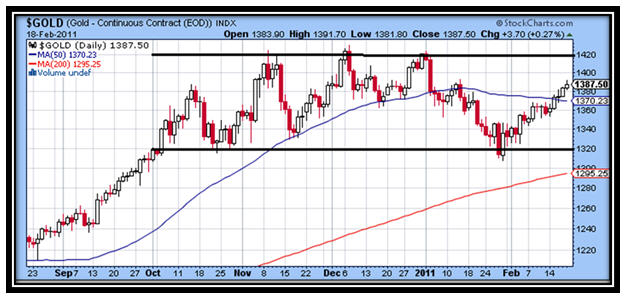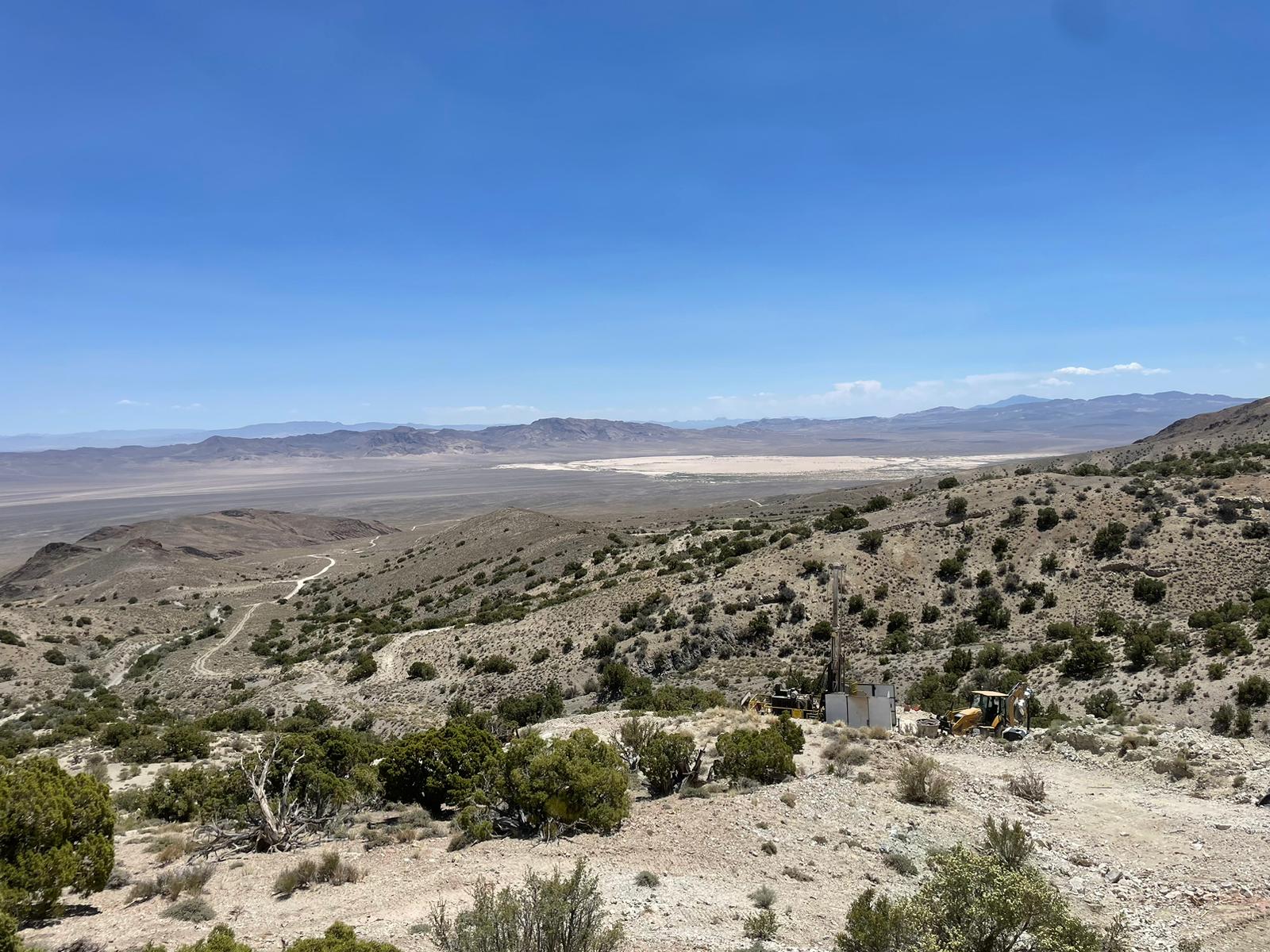Gold rises with Middle East tensions
With tensions rising in the Middle East individuals turn to gold as a safe haven asset.
Gold prices broke above $1400 an ounce, as the unrest in the Middle East continues to escalate.
Dozens of people were reported killed in Libya as anti-government protests reached the capital for the first time and several cities in the east appeared to be in the hands of the opposition. Anti-government protesters rallied in Tripoli’s streets, tribal leaders spoke out against Gaddafi, and army units defected to the opposition in a revolt that has cost the lives of more than 200 people. Protesters said they had taken control of Benghazi in and one other city.
With autocratic governments already toppled by popular uprisings in Tunisia and Egypt, there was a sense that Gaddafi’s iron grip was being severely tested. But the wave of unrest continues to spread to other countries. There have been rallies in Morroco, Algeria, Jordan, Yemen and in Bahrain tensions are still high after riot police open fire on protesters trying to reclaim landmark Pearl Square last week. At least eight people have been killed and hundreds injured in the clashes since the unrest spilling across the Arab world reached the Gulf last week.
Who would have thought that such unrest would have occurred in this region? It just goes to show how unpredictable life can be, and how sudden unexpected events can change the course of our lives – for the good and for the bad. In times such as these, there is absolutely no ways I am not going to put my faith in politicians or central bankers. With a stroke of a pen they can ruin us. So, I’ll continue to keep my faith in precious metals.
While these pockets of resistance proliferate around the middle- east, we must not lose focus on the main driving force behind the higher prices in gold. Many investors are looking at gold as a way to protect their wealth as a major currency meltdown looks more imminent. Last week gold prices advanced on the back of numerous factors. The increase in prices began following news of the US President’s $3.7 trillion budget for next year and mounting fears of inflation, prompting many investors to strengthen their positions in precious metals as a safe haven for their wealth. The U.S. budget deficit has been growing steadily since 2000 and took a sharp increase in 2007 according to the U.S. Congressional Budget Office. Many economists feel that this level of debt on either a governmental or public level is not sustainable in the long-term. However, the U.S. government continues to borrow money in order to fund numerous programs, prompting concerns regarding President Obama’s recent $3.7 trillion budget. Inflation fears are growing as a result of this news.
At the moment there are a multitude of factors that suggest that we are heading for another financial crisis. The expansionary monetary policies of the US Federal Reserve and other central banks are going to lead a further debasement of some of the major currencies, in particular the US dollar and the euro. This policy is also putting inflationary pressure on agricultural commodities, oil and of course precious metals. The rising prices of agricultural commodities are being exacerbated by the current extreme weather patterns all over the globe and as we have already seen, these rising prices have sparked riots in various countries.
The US Fed Chairman, Ben Bernanke defended his loose monetary policy in advanced economies against accusations that it is overheating emerging markets, saying factors such as exchange rate rigidity are also to blame. Speaking at an economic summit in Paris, he acknowledged that strong capital flows from advanced economies to emerging markets may be having negative spillover effects.
“Capital flows are once again posing some notable challenges for international macroeconomic and financial stability,” he said. Many emerging nations blame loose monetary policy in the developed world for creating a rush of “hot” money that is destabilising their economies by inflating commodity prices and stoking inflation. However, Bernanke said that although policy-makers in the emerging markets clearly face challenges, such concerns should be weighed against stronger emerging market growth and steps emerging economies themselves can take.
Several countries in the Eurozone are on the brink of insolvency, Japan’s national debt is over 200% and the global financial system is growing concerned about the exploding debt of the United States. As the world’s financial system teeters on the edge of collapse, geopolitical tensions are escalating, and unrest is spreading through the Middle East/North African region on a scale unimaginable only a few weeks ago.
The Chinese central bank the PBoC raised the bank reserve ratios again, by 50bp, effective February 24, to curb lending and cool the economy. This is the second time the PBoC raised reserve requirement ratio this year. The PBoC hiked benchmark lending and deposit interest rates earlier this month. China has raised reserve requirements six times and interest rates twice last year. Analysts believe that there will be more monetary tightening as China attempts to bring inflation down to this year’s target of 4%.
Minutes of the January FOMC meeting unveiled that policymakers are more confident that the economic recovery will gather some traction even though the pace of improvement in the job market has been rather disappointing. It appeared the more hawkish members would tolerate QE2 to be carried out until expiry but they would not support additional measures. The new set of economic projections showed more upbeat forecasts on growth and employment outlooks while the prospect for inflation remained subdued.
The euro received a small boost on the back of Portugal’s bond sales as well as hawkish comments from ECB officials. ECB executive board member Bini Smaghi said on Friday that “as the economy gradually recovers and global inflationary pressures arise, the degree of accommodation of monetary policy has to be monitored and, if needed, corrected.” When asked about whether ECB would raise rate this year, Bini Smaghi reiterated that “the ECB’s objective is to maintain price stability for the euro area as a whole.” The comment alone sent EUR/USD up over 100 pips.
The pound slumped against the US dollar and the euro as the BOE reduced its growth forecasts despite a higher inflationary outlook in the near-term. According to its quarterly inflation report, the BOE believes that inflation will most likely fall slightly below the target in the second half of 2012. Policymakers forecast inflation will peak at around 4.4% this year before easing to the 2% target by mid-2012 and then to 1.7% by 1Q13. This was the highest level since November 2008 and was mainly driven by hikes in VAT and energy prices. The BOE left the Bank rate unchanged at 0.5% and the asset-purchase program at 200 billion pounds.
The BoJ left rates unchanged at 0-0.1% as widely expected. The bank also upgraded its economic outlook for the first time in nine months. The BoJ also pledged to maintain its loose monetary policy stance for the country to “overcome deflation and return to a sustainable growth path with price stability.”
It is no wonder gold prices are on the move again!
TECHNICAL ANALYSIS
The price of gold has found good support around $1325. I believe that it will shortly test the key resistance level of $1425.
David Levenstein is a leading expert on investing in precious metals . Although he began trading silver through the LME in 1980, over the years he has dealt with gold, silver, platinum and palladium. He has traded and invested in bullion, bullion coins, mining shares, exchange traded funds, as well as futures for his personal account as well as for clients.
His articles and commentaries on precious metals have been published in dozens of newspapers, publications and websites both locally as well as internationally. He has been a featured guest on numerous radio and TV shows, and is a regular guest on JSE Direct, a premier radio business channel in South Africa. The largest gold refinery in the world use his daily and weekly commentaries on gold.
David has lived and worked in Johannesburg, Los Angeles, London, Hong Kong, Bangkok, and Bali.
For more information go to: www.lakeshoretrading.co.za
Information contained herein has been obtained from sources believed to be reliable, but there is no guarantee as to completeness or accuracy. Any opinions expressed herein are statements of our judgment as of this date and are subject to change without notice.
{{ commodity.name }}
{{ post.title }}
{{ post.date }}


Comments